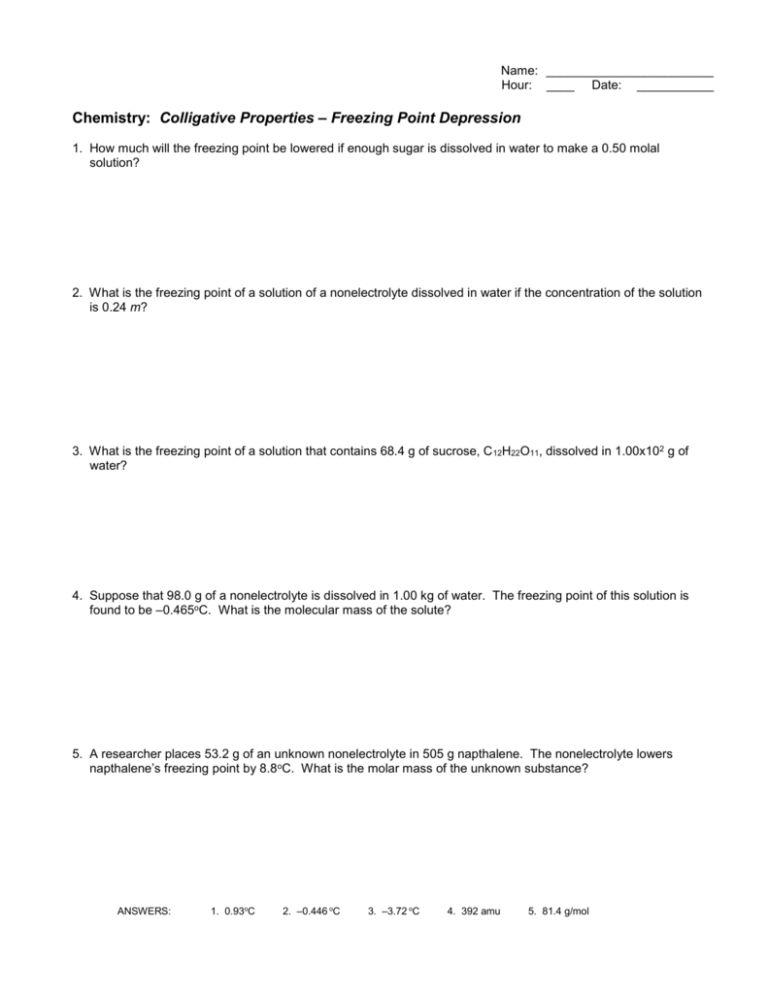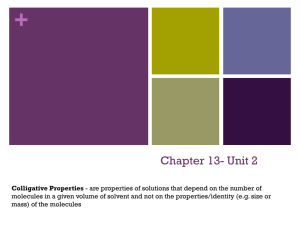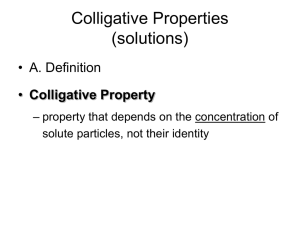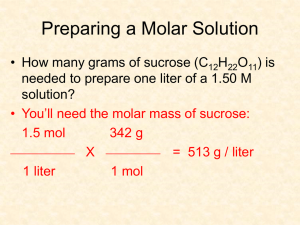Colligative Properties
advertisement

Name: ________________________ Hour: ____ Date: ___________ Chemistry: Colligative Properties – Freezing Point Depression 1. How much will the freezing point be lowered if enough sugar is dissolved in water to make a 0.50 molal solution? 2. What is the freezing point of a solution of a nonelectrolyte dissolved in water if the concentration of the solution is 0.24 m? 3. What is the freezing point of a solution that contains 68.4 g of sucrose, C 12H22O11, dissolved in 1.00x102 g of water? 4. Suppose that 98.0 g of a nonelectrolyte is dissolved in 1.00 kg of water. The freezing point of this solution is found to be –0.465oC. What is the molecular mass of the solute? 5. A researcher places 53.2 g of an unknown nonelectrolyte in 505 g napthalene. The nonelectrolyte lowers napthalene’s freezing point by 8.8oC. What is the molar mass of the unknown substance? ANSWERS: 1. 0.93oC 2. –0.446 oC 3. –3.72 oC 4. 392 amu 5. 81.4 g/mol Name: ________________________ Hour: ____ Date: ___________ Chemistry: Colligative Properties – Boiling Point Elevation 1a. What is the molal boiling point constant for carbon tetrachloride? b. The boiling point of carbon tetrachloride is 76.8oC. A given solution contains 8.10 g of a nonvolatile electrolyte in 300 g of CCl4. It boils at 78.4oC. What is the gram molecular mass of the solute? 2. The molal boiling point constant for ethyl alcohol is 1.22 oC/molal. Its boiling point is 78.4oC. A solution of 14.2 g of a nonvolatile nonelectrolyte in 264 g of the alcohol boils at 79.8 oC. What is the gram molecular mass of the solute? 3. Calculate the mass of a mole of a compound that raises the boiling point of water to 100.78 oC at 101.3 kPa when 51 g of the compound is dissolved in 500 g of water. 4. Suppose that 13 g of a nonelectrolyte is dissolved in 0.50 kg of benzene. The boiling point of this solution is 80.61oC. What is the molecular mass of the solute? ANSWERS: 1b. 84.9 g/mol 2. 46.7 g/mol 3. 67 g/mol 4. 129 amu Name: _________________________ Hour: ____ Date: ___________ Chemistry: Electrolytes and Colligative Properties 1. Write the dissociation for the following: a. strontium nitrate b. calcium chloride c. magnesium sulfate d. potassium iodide Also, calculate the concentrations of the products assuming each reactant is 0.1 molal. 2. What is the expected freezing point for a solution that contains 2.0 mol of magnesium sulfate dissolved in 500 mL of water? 3. What is the expected change in the freezing point of water in a solution of 62.5 g of barium nitrate, Ba(NO 3) 2, in 1.00 kg of water? 4. What is the expected boiling point of water for a solution that contains 150 g of sodium chloride dissolved in 1.0 kg of water? ANSWERS: 1a/b. 0.3 molal 1c/d. 0.2 molal 2. – 14.9 oC 3. – 1.3 oC 4. 102.6 oC Name: _________________________ Hour: ____ Date: ___________ Chemistry: Review Colligative Properties 1. A water solution containing an unknown quantity of a nonelectrolyte solute is found to have a freezing point of – 0.23oC. What is the molal concentration of the solution? 2. What is the boiling point of a solution of ethyl alcohol, C2H5OH, that contains 20.0 g of the solute dissolved in 250 g of water? 3. A solution contains 4.50 g of a nonelectrolyte dissolved in 225 g of water and has a freezing point of –0.310o C. What is the gram formula mass of the solute? 4. How many grams of ethylene glycol, C2H4(OH) 2, must a researcher add to 500 g of water to yield a solution that will freeze at –7.44oC? [Hint: you need to find the molal freezing constant, Kf, for ethylene glycol] ANSWERS: 1. 0.124 molal 2. 100.89 oC 3. 120 g/mol 4. 24 g 5. Which of the following two solutes will raise the boiling point of water in a car’s radiator more: 1.00 mol of ethylene glycol or 1.00 mol of ethyl alcohol? Explain. 6. The freezing point of an aqueous sodium chloride solution is –20.0oC. What is the molarity of the solution? 7. What is the expected boiling point of a solution prepared by dissolving 117 g of NaCl in 463 mL of acetic acid? (Assume the density of acetic acid is 1.08 g/mL) ANSWERS: 5. ?? 6. 5.4 molal 7. 142.5oC Colligative Properties Useful Equations: Tf = Kf m Solvent acetic acid acetone benzene camphor carbon tetrachloride chloroform ether ethyl alcohol ethylene glycol methyl alcohol formic acid napthalene phenol toluene water Tb = Kb m Normal Freezing Point (oC) 16.6 - 95.4 5.5 178.8 - 23.0 - 63.5 - 116.3 - 117.3 - 13.5 - 97.8 8.3 80.2 40.9 - 94.5 0.0 molality = Molal Boiling Point Constant Kb (oC/molal) 3.07 1.71 2.53 5.61 5.03 3.63 2.02 1.22 0.83 3.56 3.56 3.33 0.512 mol of solute kg of solvent Normal Boiling Point (oC) 117.9 56.2 80.1 207.4 76.7 61.2 34.6 78..3 197.2 64.5 100.8 217.7 181.8 110.7 100.0 MM = grams moles Molal Freezing Point Constant Kf (oC/molal) - 3.90 - 4.90 - 39.7 - 1.79 - 2.77 - 6.8 - 7.40 - 1.86 ................................................................................................................................................................. C U T H E R E .................................................................................................................................................................. Colligative Properties Useful Equations: Tf = Kf m Solvent acetic acid acetone benzene camphor carbon tetrachloride chloroform ether ethyl alcohol ethylene glycol methyl alcohol formic acid napthalene phenol toluene water Tb = Kb m Normal Freezing Point (oC) 16.6 - 95.4 5.5 178.8 - 23.0 - 63.5 - 116.3 - 117.3 - 13.5 - 97.8 8.3 80.2 40.9 - 94.5 0.0 molality = Molal Boiling Point Constant Kb (oC/molal) 3.07 1.71 2.53 5.61 5.03 3.63 2.02 1.22 0.83 3.56 3.56 3.33 0.512 mol of solute kg of solvent Normal Boiling Point (oC) 117.9 56.2 80.1 207.4 76.7 61.2 34.6 78..3 197.2 64.5 100.8 217.7 181.8 110.7 100.0 MM = grams moles Molal Freezing Point Constant Kf (oC/molal) - 3.90 - 4.90 - 39.7 - 1.79 - 2.77 - 6.8 - 7.40 - 1.86 KEY Chemistry: Colligative Properties – Freezing Point Depression 1. How much will the freezing point be lowered if enough sugar is dissolved in water to make a 0.50 molal solution? ΔTf = K f m ΔTf = -1.86 o C/molal 0.50 molal ΔTf = -0.93 C o 2. What is the freezing point of a solution of a nonelectrolyte dissolved in water if the concentration of the solution is 0.24 m? ΔTf = K f m Normal freezing point of water is 0.0 o C. ΔTf = -1.86 o C/molal 0.24 molal freezing point = - 0.446 o C ΔTf = -0.446 C o 3. What is the freezing point of a solution that contains 68.4 g of sucrose, C 12H22O11, dissolved in 1.00x102 g of water? 1 mol C12H22 O11 x mol C12H22 O11 = 68.4 g C12H22 O11 0.2 molal 342 g C12H22 O11 m= mol solute 0.2 mol kg solvent 0.1 kg ΔTf = K f m ΔTf = -1.86 o C/molal 2 molal m = 2 molal freezing point = - 3.72 o C ΔTf = - 3.72 C o 4. Suppose that 98.0 g of a nonelectrolyte is dissolved in 1.00 kg of water. The freezing point of this solution is found to be –0.465oC. What is the molecular mass of the solute? m= ΔTf = K f m - 0.465 o C = -1.86 o C/molal m mol solute kg solvent 0.25 molal = x mol 1 kg Molar Mass = g mol Molar Mass = 98 g 0.25 mol m = 0.25 molal x = 0.25 mol solute Molar Mass = 392 g/mol 392 amu 5. A researcher places 53.2 g of an unknown nonelectrolyte in 505 g napthalene. The nonelectrolyte lowers napthalene’s freezing point by 8.8oC. What is the molar mass of the unknown substance? m= ΔTf = K f m - 8.8 o C = -6.8 o C/molal m mol solute kg solvent 1.294 molal = x mol 0.505 kg Molar Mass = g mol Molar Mass = 53.2 g 0.654 mol m = 1.294 molal x = 0.654 mol solute Molar Mass = 81.4 g/mol KEY Chemistry: Colligative Properties – Boiling Point Elevation 5.03 oC/molal 1a. What is the molal boiling point constant for carbon tetrachloride? b. The boiling point of carbon tetrachloride is 76.8oC. A given solution contains 8.10 g of a nonvolatile electrolyte in 300 g of CCl4. It boils at 78.4oC. What is the gram molecular mass of the solute? m= ΔTb = K b m 78.4 o C 1.6 o C = 5.03 o C/molal m o - 76.8 C T = 1.6 o C mol solute kg solvent 0.3181 molal = x mol 0.3 kg Molar Mass = g mol Molar Mass = 8.10 g 0.0954 mol m = 0.3181 molal x = 0.0954 mol solute Molar Mass = 84.9 g/mol 2. The molal boiling point constant for ethyl alcohol is 1.22 oC/molal. Its boiling point is 78.4oC. A solution of 14.2 g of a nonvolatile nonelectrolyte in 264 g of the alcohol boils at 79.8 oC. What is the gram molecular mass of the solute? mol solute g m= Molar Mass = kg solvent mol ΔTb = K b m 79.8 o C 1.4 o C = 1.22 o C/molal m o - 78.4 C T = 1.4 o C 1.51 molal = x mol 0.264 kg Molar Mass = 14.2 g 0.304 mol m = 1.51 molal x = 0.304 mol solute Molar Mass = 46.7 g/mol 3. Calculate the mass of a mole of a compound that raises the boiling point of water to 100.78 oC at 101.3 kPa when 51 g of the compound is dissolved in 500 g of water. m= 100.78 o C ΔTb = K b m - 100.00 C 0.78 o C = 0.52 o C/molal m T = 0.78 o C m = 1.5 molal o mol solute kg solvent 1.5 molal = x mol 0.5 kg x = 0.75 mol solute Molar Mass = g mol Molar Mass = 51 g 0.75 mol Molar Mass = 67 g/mol 4. Suppose that 13 g of a nonelectrolyte is dissolved in 0.50 kg of benzene. The boiling point of this solution is 80.61oC. What is the molecular mass of the solute? m= 80.61o C o - 80.10 C T = 0.51o C ΔTb = K b m 0.51o C = 2.53 o C/molal m mol solute kg solvent 0.2016 molal = x mol 0.5 kg Molar Mass = g mol Molar Mass = 13 g 0.1008 mol m = 0.20 molal x = 0.1008 mol solute Molar Mass = 129 g/mol or 129 amu KEY Chemistry: Electrolytes and Colligative Properties 1. Write the dissociation for the following: a. strontium nitrate b. calcium chloride c. magnesium sulfate Sr(NO3) 2 (aq) Sr2+(aq) 0.1 molal 0.1 m CaCl 2 (aq) Ca2+(aq) 0.1 m MgSO4 (aq) Mg2+(aq) 0.1 molal 0.1 m KI (aq) K1+(aq) 0.1 molal 0.1 m d. potassium iodide 2 (0.1 molal) 0.2 m 2 Cl1- (aq) + 0.1 molal 2 NO31- (aq) + 0.2 m + SO42- (aq) 0.1 m I1- (aq) + 0.1 m Also, calculate the concentrations of the products assuming each reactant is 0.1 molal. 2. What is the expected freezing point for a solution that contains 2.0 mol of magnesium sulfate dissolved in 500 mL of water? m= mol solute 2.0 mol kg solvent 0.5 kg m = 4 molal 2 "ions" MgSO 4 Mg 2+ 4m 4m ΔTf = K f m ΔTf = -1.86 o C/molal 8 molal "ions" 8 molal + SO 4 ΔTf = - 14.9 C o 2 4m 3. What is the expected change in the freezing point of water in a solution of 62.5 g of barium nitrate, Ba(NO 3) 2, in 1.00 kg of water? 1 mol Ba NO3 2 x mol Ba NO3 2 = 62.5 g Ba NO3 2 261.34 g Ba NO3 2 m= mol solute 0.239 mol kg solvent 1 kg m = 239 molal 3 "ions" ΔTf = K f m 0.239 mol Ba NO3 2 ΔTf = -1.86 o C/molal 0.717 molal "ions" 0.717 molal ΔTf = - 1.33 o C 4. What is the expected boiling point of water for a solution that contains 150 g of sodium chloride dissolved in 1.0 kg of water? 1 mol NaCl x mol NaCl = 150 g NaCl 2.57 mol NaCl 58.4 g NaCl m= mol solute 2.57 mol kg solvent 1 kg m = 2.57 molal 2 "ions" ΔTb = K b m ΔTb = 0.512 o C/molal 5.13 molal "ions" 5.13 molal ΔTb = 2.6 C o expected b.p. = 102.6 o C KEY Chemistry: Review Colligative Properties 1. A water solution containing an unknown quantity of a nonelectrolyte solute is found to have a freezing point of – 0.23oC. What is the molal concentration of the solution? ΔTf = K f m - 0.23 o C = -1.86 o C/molal m m = 0.124 molal 2. What is the boiling point of a solution of ethyl alcohol, C2H5OH, that contains 20.0 g of the solute dissolved in 250 g of water? m= 1 mol x mol C2 H5 OH = 20.0 g C2H5 OH 46 g x = 0.435 mol C2H5 OH mol solute kg solvent ΔTb = K b m ΔTf = 0.512 o C/molal 1.74 molal 0.435 mol 4 molal = 0.250 kg x = 1.74 molal C2 H5 OH ΔTf = 0.89 C o boiling point is 100.89 o C 3. A solution contains 4.50 g of a nonelectrolyte dissolved in 225 g of water and has a freezing point of –0.310o C. What is the gram formula mass of the solute? m= ΔTf = K f m - 0.310 o C = -1.86 o C/molal m mol solute kg solvent 0.167 molal = x mol 0.225 kg Molar Mass = g mol Molar Mass = 4.50 g 0.0375 mol m = 0.167 molal x = 0.0375 mol solute Molar Mass = 120 g/mol 4. How many grams of ethylene glycol, C2H4(OH) 2, must a researcher add to 500 g of water to yield a solution that will freeze at –7.44oC? m= ΔTf = K f m - 7.44 o C = -1.86 o C/molal m mol solute kg solvent 4 molal = x mol 0.5 kg m = 4 molal 62 g x g C2 H4 (OH)2 = 2 mol C2H4 (OH)2 1 mol x = 124 g C2H4 (OH)2 x = 2 mol solute ANSWERS: 1. 0.124 molal 2. 100.89 oC 3. 120 g/mol 4. 124 g 5. Which of the following two solutes will raise the boiling point of water in a car’s radiator more: 1.00 mol of ethylene glycol or 1.00 mol of ethyl alcohol? Explain. Both substances would initially have the same protective effect. A colligative property is only dependant on the number of particles present – both the ethylene glycol and ethyl alcohol contain 1 mole or 6.02 x 1023 particles. However, ethyl alcohol is volatile and will rapidly evaporate (and is very flammable) and should not be used in a car’s radiator. Therefore, ethylene glycol should be used as the solute added to water to fill a car’s radiator! 6. The freezing point of an aqueous sodium chloride solution is –20.0oC. What is the molarity of the solution? Sodium chloride, NaCl, dissociates into two ions: Na+(aq) + Cl1-(aq) NaCl(aq) --> Na+(aq) + Cl1-(aq) 5.38 m 5.38 m 5.38 m ΔTf = K f m i - 20.0 o C = -1.86 o C/molal m (2) m = 5.38 molal 7. What is the expected boiling point of a solution prepared by dissolving 117 g of NaCl in 463 mL of acetic acid? (Assume the density of acetic acid is 1.08 g/mL) Step 1) 1 mol x mol NaCl = 117 g NaCl 58.5 g x = 2 mol NaCl Step 2) 1.08 g 1 kg x kg = 463 mL acetic acid = 0.5 kg 1 mL 1000 g Step 3) m= mol solute kg solvent ΔTb = K b m i Step 4) 2 mol 0.5 kg 4 molal ΔTb = 3.07 o C/molal 4 (2) ΔTb = 14.46 C o 117.9o C Step 5) normal boiling point = + 24.6o C 142.5o C ANSWERS: "expected" boiling point 5. ?? 6. 5.4 molal 7. 142.5oC Colligative Properties Useful Equations: Tf = Kf m Solvent acetic acid acetone benzene camphor carbon tetrachloride chloroform ether ethyl alcohol ethylene glycol methyl alcohol formic acid napthalene phenol toluene water Tb = Kb m Normal Freezing Point (oC) 16.6 - 95.4 5.5 178.8 - 23.0 - 63.5 - 116.3 - 117.3 - 13.5 - 97.8 8.3 80.2 40.9 - 94.5 0.0 molality = Molal Freezing Point Constant Kf (oC/molal) - 3.90 - 4.90 - 39.7 - 1.79 - 2.77 - 6.8 - 7.40 - 1.86 mol of solute kg of solvent Normal Boiling Point (oC) 117.9 56.2 80.1 207.4 76.7 61.2 34.6 78..3 197.2 64.5 100.8 217.7 181.8 110.7 100.0 MM = grams moles Molal Boiling Point Constant Kb (oC/molal) 3.07 1.71 2.53 5.61 5.03 3.63 2.02 1.22 0.83 3.56 3.56 3.33 0.512 ................................................................................................................................................................. C U T H E R E .................................................................................................................................................................. Colligative Properties Useful Equations: Tf = Kf m Solvent acetic acid acetone benzene camphor carbon tetrachloride chloroform ether ethyl alcohol ethylene glycol methyl alcohol formic acid napthalene phenol toluene water Tb = Kb m Normal Freezing Point (oC) 16.6 - 95.4 5.5 178.8 - 23.0 - 63.5 - 116.3 - 117.3 - 13.5 - 97.8 8.3 80.2 40.9 - 94.5 0.0 molality = Molal Freezing Point Constant Kf (oC/molal) - 3.90 - 4.90 - 39.7 - 1.79 - 2.77 - 6.8 - 7.40 - 1.86 mol of solute kg of solvent Normal Boiling Point (oC) 117.9 56.2 80.1 207.4 76.7 61.2 34.6 78..3 197.2 64.5 100.8 217.7 181.8 110.7 100.0 MM = grams moles Molal Boiling Point Constant Kb (oC/molal) 3.07 1.71 2.53 5.61 5.03 3.63 2.02 1.22 0.83 3.56 3.56 3.33 0.512








